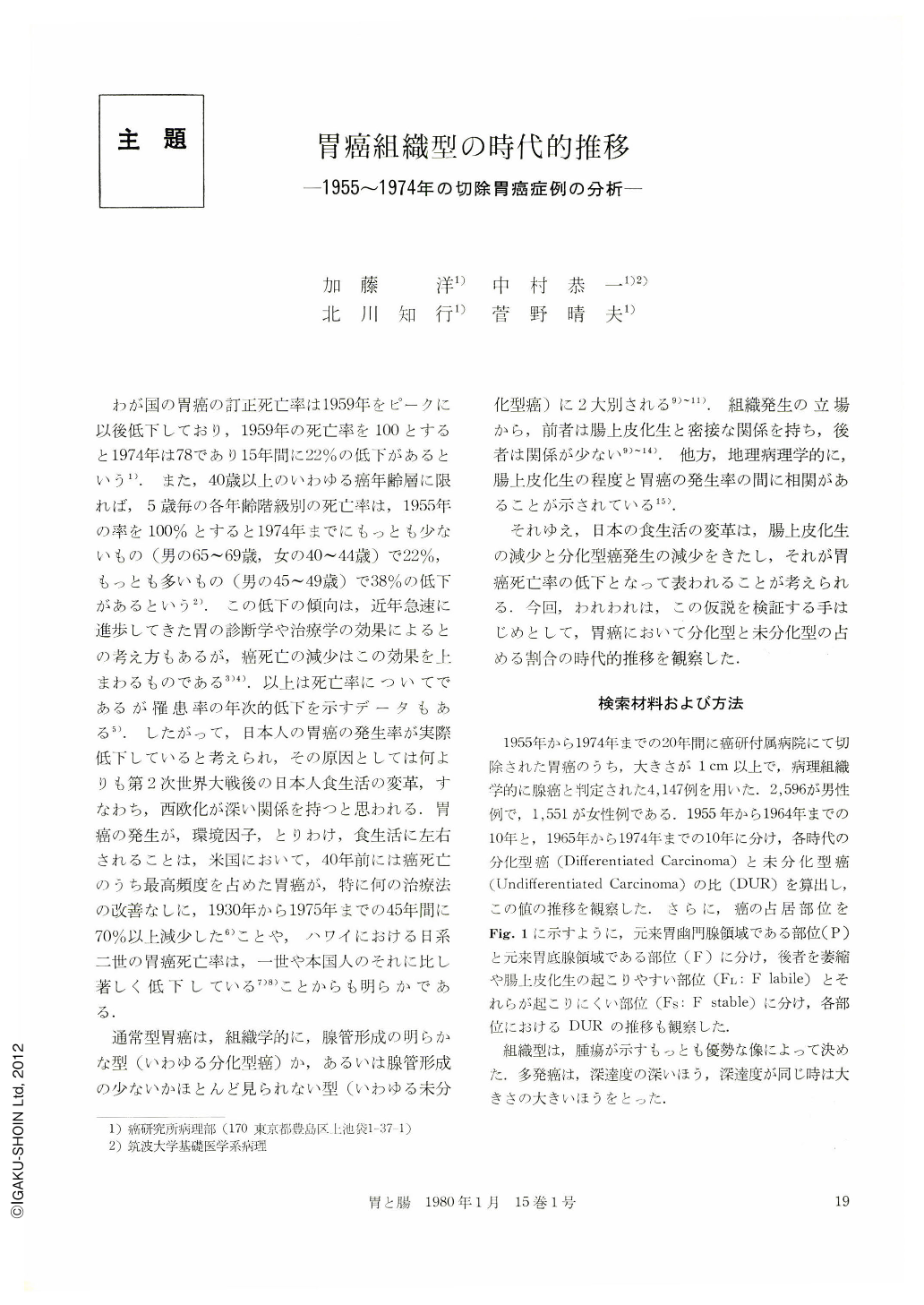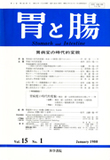Japanese
English
- 有料閲覧
- Abstract 文献概要
- 1ページ目 Look Inside
- サイト内被引用 Cited by
わが国の胃癌の訂正死亡率は1959年をピークに以後低下しており,1959年の死亡率を100とすると1974年は78であり15年間に22%の低下があるという1).また,40歳以上のいわゆる癌年齢層に限れば,5歳毎の各年齢階級別の死亡率は,1955年の率を100%とすると1974年までにもっとも少ないもの(男の65~69歳,女の40~44歳)で22%,もっとも多いもの(男の45~49歳)で38%の低下があるという2).この低下の傾向は,近年急速に進歩してきた胃の診断学や治療学の効果によるとの考え方もあるが,癌死亡の減少はこの効果を上まわるものである3)4).以上は死亡率についてであるが罹患率の年次的低下を示すデータもある5).したがって,日本人の胃癌の発生率が実際低下していると考えられ,その原因としては何よりも第2次世界大戦後の目本人食生活の変革,すなわち,西欧化が深い関係を持つと思われる.胃癌の発生が,環境因子,とりわけ,食生活に左右されることは,米国において,40年前には癌死亡のうち最高頻度を占めた胃癌が,特に何の治療法の改善なしに,1930年から1975年までの45年間に70%以上減少した6)ことや,ハワイにおける日系二世の胃癌死亡率は,一世や本国人のそれに比し著しく低下している7)8)ことからも明らかである.
通常型胃癌は,組織学的に,腺管形成の明らかな型(いわゆる分化型癌)か,あるいは腺管形成の少ないかほとんど見られない型(いわゆる未分化型癌)に2大別される9)~11).組織発生の立揚から,前者は腸上皮化生と密接な関係を持ち,後者は関係が少ない9)~14).他方,地理病理学的に,腸上皮化生の程度と胃癌の発生率の間に相関があることが示されている15).
According to statistics, the standardized mortality rate for gastric carcinoma in Japan has been decreasing since 1959. The declining rate is larger than what is expected on the basis of progress in clinical achievement. Therefore, the incidence of gastric carcinoma may be actually reducing. As has been pointed out in the case of Japanese immigrants to the United States, this declining trend may most possibly be related to the change (westernization) of dietary habit in Japan after the World War Ⅱ. It has been reported that the incidence of gastric carcinoma is in parallel with the frequency and degree of intestinal metaplasia of the gastric mucosa. We have shown that differentiated (intestinal) and undifferentiated (diffuse) type of carcinoma of the stomach develops from the intestinalized and non-intestinalized gastric mucosa, respectively. It seemed of interest, therefore, to study the chronological change, if any, in histological type of gastric carcinoma in Japan.
We analysed 4,147 cases of gastric carcinoma, 2,596 males and 1,551 females, resected at the Cancer Institute Hospital during the past 20 years from 1955 to 1974. All carcinomas were classified histologically into either differentiated 01' undifferentiated type. The ratio of differentiated to undifferentiated type (DUR) was figured out for the materials obtained during 1955 to 1964 and for those during 1965 to 1974, respectively. The DUR decreased from 1.29 to 1.18 in male and from 0.67 to 0.50 in female (Table 4). The difference was, however, statistically not significant. When we subdivided the materials according to the location of carcinoma within the stomach, decline of the DUR was significant (P<0.05) in carcinomas developing in Where we call the F-labile area (the upper lesser curvature and lower body) and that there was no remarkable change of the DUR in carcinomas developing in other locations of the stomach (Fig. 1, Table 5).
Since intestinal metaplasia of the stomach appears most commonly and early in the P area and next in the FL area, the trend described above may also indicate a tendency for decline of intestinal metaplasia in extent, but not yet in frequency.

Copyright © 1980, Igaku-Shoin Ltd. All rights reserved.


